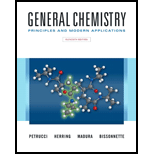
Concept explainers
Interpretation:
The mechanism for the reaction between
Concept introduction:
Nucleophilic substitution reaction
Elimination reaction is the type of reaction in which two substituents attached to the adjacent carbon atoms are removed from the reactant molecule to form the product. In
Want to see the full answer?
Check out a sample textbook solution
Chapter 27 Solutions
GENERAL CHEMISTRY-MOD.MASTERINGCHEM.
- Treatment of p-tert-butylphenol with a strong acid such as H2SO4 yields phenol and 2-methylpropene. Propose a mechanism.arrow_forward2, 3-Dimethyl-2, 3-butanediol has the common name pinacol. On heating with aqueous acid, pinacol rearranges to pinacolone, 3, 3-dimethyl-2-butanone. Suggest a mechanism for this reaction.arrow_forwardWhen cis-2-decalone is dissolved in ether containing a trace of HCl, an equilibrium is established with trans-2-decalone. The latter ketone predominates in the equilibrium mixture. Propose a mechanism for this isomerization and account for the fact that the trans isomer predominates at equilibrium.arrow_forward
- Select the necessary reagent(s) for the following transformation. a. K2Cr2O7 b. NaOH c. I2 d. Cu^2+ e. H+/H2O f. H2/Ptarrow_forwardWhen (CH3CH2)3CBr is added to CH3OH at room temperature, the major product is (CH3O)C(CH2CH3)3 and a minor product is CH3CH=C(CH2CH3)2. Propose a mechanism for the product that is formed by the substitution reaction. Use curved arrows to show the movement of electrons.arrow_forwardKk.17. Please show mechanisms/workarrow_forward
- Propose mechanisms and show the expected products of the following reactions.(a) 2,4-dinitrochlorobenzene + sodium methoxide (NaOCH3)(b) 2,4-dimethylchlorobenzene + sodium hydroxide, 350 °Carrow_forwardTreatment of (CH3)2CHCH(OH)CH2CH3 with TsOH affords two products(M and N) with molecular formula C6H12. The 1H NMR spectra of M and Nare given below. Propose structures for M and N, and draw a mechanismto explain their formation.arrow_forwardPropose mechanisms and show the expected products of the following reactions. 2,4@dimethylchlorobenzene + sodium hydroxide, 350 °Carrow_forward

 Organic ChemistryChemistryISBN:9781305580350Author:William H. Brown, Brent L. Iverson, Eric Anslyn, Christopher S. FootePublisher:Cengage Learning
Organic ChemistryChemistryISBN:9781305580350Author:William H. Brown, Brent L. Iverson, Eric Anslyn, Christopher S. FootePublisher:Cengage Learning

